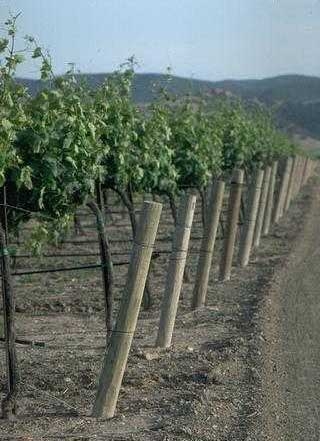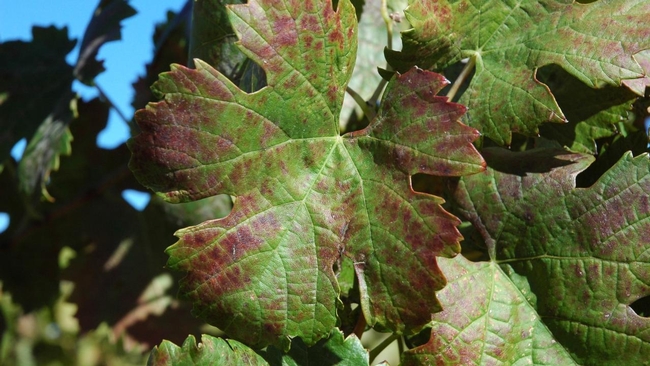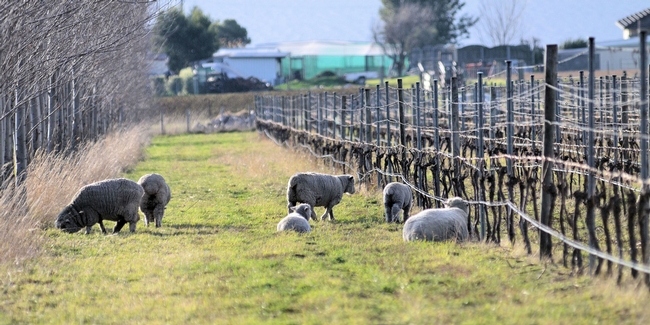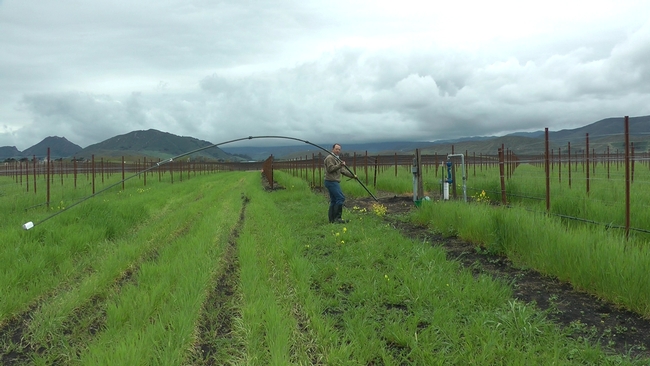Posts Tagged: vineyard
UC Davis to build new $5.25M greenhouse to protect U.S. grapevine collection
Project designed to prevent red blotch and other grapevine diseases
A new, $5.25 million greenhouse is being built on the University of California, Davis, campus to safeguard an important grapevine collection from red blotch disease and other pathogens.
The 14,400-square-foot greenhouse will have a vestibuled entry, be insect-proof and provide another level of disease protection. It is being spearheaded by Foundation Plant Services, or FPS, which provides the U.S. grape industry with high-quality, virus-tested grapevine plant material.
The program serves as the primary source for grapevine plant material distributed to nurseries under the California Department of Agriculture's Grapevine Registration and Certification Program, which provides the majority of grapevines planted in the United States. For the grape industry, it is essential to protect this material from disease-carrying insects and guarantee fast access to clean plant material.
“The program is considered the largest quarantine center for the grapevine industry in the United States,” said Maher Al Rwahnih, a plant pathologist and FPS director. “This is kind of a game changer for us.”
A history of serving the grapevine industry
FPS has maintained healthy grapevine planting stock on the UC Davis campus for more than 70 years in open fields at the Classic and Russell Ranch foundation vineyards. FPS scientists first detected grapevine red blotch virus at Russell Ranch in 2017. By 2021, an estimated 51.6% of the crop there was infected. Material from that vineyard is not being sold, and the site is now part of an epidemiological study to try to pinpoint how the disease is transmitted.
FPS pathologists have detected red blotch on less than 1% of the Classic vineyard crop. But it may not always be that way in the future.
“We don't know how long the Classic vineyard will remain clean,” Al Rwahnih said. “Every testing season, this is what keeps me up at night. We're not sure why it's happening in Russell Ranch and not the Classic vineyard.”
Once the greenhouse is operating, grapevines propagated from plant material from the Classic vineyard will be moved into the greenhouse, tested and verified as clean from disease. From there it will be sold to nurseries, which will grow additional plants to sell to growers.
Two greenhouses part of plan
Normally the foundation has 4,000 vines available, but the greenhouse will only house 2,000 vines, so inventory will be cut in half.
“This phase is just a starting phase,” Al Rwahnih said. “It's not sufficient for our needs.”
FPS plans to build another greenhouse in the next two to three years to increase capacity.
Industry groups and FPS identified greenhouses as the best way to protect the plants from red blotch and other pathogens transmitted by insects. They are also consulting with those same people on the grape varieties to include in the greenhouse.
“We have a large selection, and we need to make sure all the varieties that are important to industry are contained,” he said.
The first greenhouse is expected to be finished by the end of 2023.
Funding for the first greenhouse is coming from a variety of sources. The California Fruit Tree, Nut Tree and Grapevine Improvement Advisory Board, managed by the California Department of Food and Agriculture, contributed $4 million to the project. The California Grape Rootstock Research Foundation gave $500,000, Foundation Plant Services with UC Davis is funding $450,000, and the California Grape Rootstock Commission gave $100,000.
“This is crucial for the grapevine industry, and we are very grateful for the support,” Al Rwahnih said.
On the topic of vineyard nutrient management, farmers want to know about sheep
The UC Sustainable Agriculture Research and Education Program is working to build an online community for growers facing challenges and trying innovative approaches to how they manage nutrients on the farm. With the help of FarmsReach and Sustainable Conservation, we've been working to build up an online group based on nutrient management to discuss a wide array of practices. For two weeks in January, we hosted a discussion on nutrient management for vineyards, particularly in times of drought.
In a recent Capital Public Radio story on winemakers struggling with groundwater shortages this year, winemaker Chris Leamy said “the drought has helped to spur change and innovation.” When business as usual is not an option, farmers get creative. Through discussion, informational videos, and a tool kit of resources, farmers and UC advisors shared some of the creative ways that growers are adapting to water limitations and building healthy soil in their vineyards.
One discussion to rise to the surface throughout was the use of animals in vineyard systems. Farmers with experience running animals through their vineyards chimed in with valuable insights.
Some thoughts repeated by several growers were:
- Short breeds like babydoll sheep and tall cordons on vines make sheep less able to graze on the canopy. Some growers use electrified deterrents running parallel to the trellis to allow sheep to stay in the vineyard into the summer with no leaf damage. Growers who kept sheep in vineyards year round described eliminating mowing completely.
- Drip lines need to be tall enough to be out of reach from sheep.
- Move sheep frequently to prevent soil compaction.
- One grower runs chickens through the vineyard at the end of the season, but says to avoid the practice if shoot growth has been too vigorous — the added nutrients from the chickens may give vines an unwanted boost in the spring.
- Growers who use sheep in their vineyards describe significant nutrient inputs from sheep, some to the point of eliminating other fertilizers altogether.
You can follow more of the conversation here. The group of participants is growing (94 strong now!) and we'll be hosting future discussions on different topics. This project is hosted by UC SAREP as part of the Solution Center for Nutrient Management. You can join our mailing list to stay up-to-date with our activities, online discussions, and updates to our website.
UC study shows promise for protecting coastal winegrapes from frost
In California’s coastal winegrape-growing regions, a spring freeze can be devastating. Tender shoots and leaves burn back, causing damage that reduces the crop yield when it is harvested many months later.
“We’ve had some very severe frosts in San Luis Obispo County and on the Central Coast over the years,” said Mark Battany, UC Cooperative Extension advisor in San Luis Obispo and Santa Barbara counties. “In 2011 we had the most severe frost in 30 years and many millions of dollars of crop and wine value were lost because of that freeze.”
Farmers take various measures to protect their crops when temperatures dip below freezing, such as mowing or tilling the vineyard row middles, or running sprinklers with water pumped from underground aquifers or diverted from streams.
“Sprinkler frost protection is very effective in many areas,” Battany said. “The concern we have in California is that water is becoming more limited. We don’t have the ability to easily import water from other areas to our coastal regions, and our local supplies are being stretched quite thin.”
Some farmers are considering wind machines, which mix warmer air high above the ground with air closer to the ground to raise the temperature. But wind machines are expensive, and the potential effectiveness depends on the strength of the temperature inversion. UC scientists are now gathering data to help inform farmers before making the costly investment.
Battany and his colleagues - Rhonda Smith, UCCE advisor in Sonoma County, Richard Snyder, UCCE specialist in the Department of Land, Air and Water Resources at UC Davis, and Gwen Tindula, UCCE staff research associate - are collecting temperature inversion data at different locations in 60 coastal vineyards throughout three counties to document inversions during frost events.
The scientists installed 35-foot-high meteorological towers with data loggers at the top and at the five-foot height to measure the difference in temperature. In the first year of the study, there were useful inversion conditions on nearly three-fourths of the nights when there was frost.
“That’s a fairly good success rate,” Battany said. “The wind machine will provide quite a bit of protection under those conditions.”
The study will continue this year and in 2014. Farmers who wish to install their own meteorological towers with data loggers can do so at a cost of about $250 each. Installation instructions and specifications are available on the UCCE website.
The UCCE research is funded with a grant from the American Vineyard Foundation and a CDFA Specialty Crops Block Grant.
For more details, see the video below:
Winemaking venture initiated by former UCCE advisor
Former Fresno County UC Cooperative Extension farm advisor, Lowell Zelinski, and his wife are launching a new luxury winemaking course in Paso Robles to operate in conjunction with their agricultural management business, according to a story in the Santa Maria Times.The Zelinskis began working with Central Coast vineyards in 2003; a few years later they began making wine from vines they were managing, a process documented by Becky Zelinski, an aspiring photographer.
Their friends were envious, the newspaper reported. "The Zelinskis then wondered if their friends’ interest could translate into a do-it-yourself winemaking business," wrote reporter Laurie Jervis.
In 2008, 14 friends and friends of friends spent a weekend in a cabernet sauvignon vineyard, picking and de-stemming the grapes by hand.
In 2009, the couple offered three weekend sessions on three different varietals. The weekends included meals prepared by a local chef to complement the varietal under study.
“These are the vineyards that we have relationships with all year," Mrs. Zelinski was quoted in the paper. "Many of the people (involved in those vineyards) are excited about our concept and want to help."

vineyard



